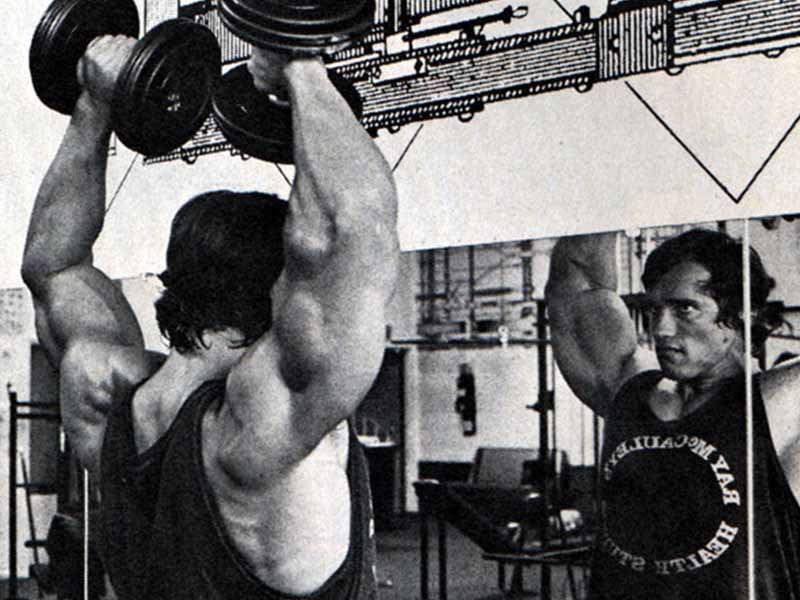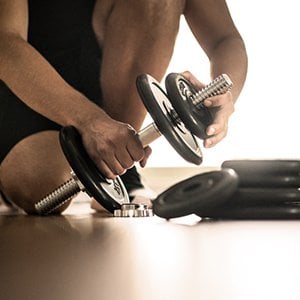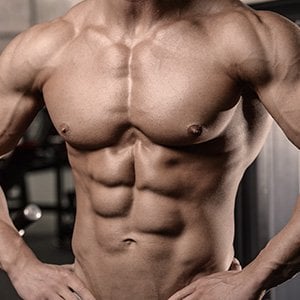
Best Shoulder Workouts & Exercises
Have you been hitting the gym regularly, but are still disappointed in your shoulder definition?
Looking for some of the best shoulders workouts to give you that chiseled look you’ve been longing for?
Well you’re in luck because today we are going to show you just that. We’ve put together a list of some of the best shoulder exercises for symmetrically broad shoulders.
Old schoolers in the Golden Era were no strangers to building up their shoulders. They typically would work different muscle groups every day to the point of exhaustion.

The repeated and sustained abuse their bodies took was impressive. If they weren’t careful, they would risk injuring themselves and derailing their progress.
If you are looking to get a nicely formed broad shoulders look, then you need to work out correctly. People tend to focus on just one of the shoulder muscles and neglect the other two. By doing that, they end up with a lopsided look to their shoulders.
The Shoulder: Deconstructed
Before we get into the best shoulder workouts for a symmetrical look, let’s view the shoulder itself. The shoulder muscles are made up of three “heads”:
- Anterior head – this is the front of the shoulder muscle, commonly referred to as the front delt or deltoid
- Lateral head – this is the center of the shoulder muscle, commonly referred to as the middle delt or deltoid
- Posterior head – this is the back of the shoulder muscle, commonly referred to as the back delt or deltoid

The rotator cuff is what protects your shoulder joint and allows you to raise your arms over your head. The muscles that make up the rotator cuff are:
- Supraspinatus – This muscle helps to lift your arm. It provides stability to your upper arm and keeps your humerus (upper arm bone) in place.
- Infraspinatus – The largest muscle of your rotator cuff. This muscle rotates and extends your shoulder.
- Teres minor – This is the smallest muscle in your rotator cuff. It assists in rotating your arm away from your body.
- Subscapularis – This muscle attaches your humerus to your shoulder blade. It allows your arm to rotate, lower and be held straight out.

Common Shoulder Injuries
Shoulder injuries are common in people who lift too heavy or don’t lift properly. Working each shoulder muscle to strengthen it can help avoid injury. Some of the most common shoulder injuries include:
- Tendinitis – This is caused when the tendon in the shoulder gets irritated or inflamed.
- Bursitis – The bursa is a fluid filled sac that protects your rotator cuff. Repetitive motions can cause inflammation or irritation to the bursa.
- Rotator cuff tear – This can be partial (the muscle tears or frays) or complete (the muscle rips completely). A tear is typically caused by repetitive motions or with normal wear and tear.
- Impingement – This happens when one of the tendons in your rotator cuff gets injured. The inflammation causes it to get pinched in the shoulder joint. Blood can’t flow normally because of this, and it can cause the tendon to further tear or fray.
While some of these injuries are unavoidable, you can reduce your chances of it happening to you. How? By always using proper form, not lifting too heavy, and warming up the muscle before you begin your workouts. Quality almost always wins over quantity, even when talking about muscle gains.
Overhead Press (Dumbbell or Barbell)
The standing overhead press is one of the best full shoulder workouts on our list. It primarily focuses on the anterior delt but also works the lateral, posterior, core and triceps.
When comparing the seated vs. standing overhead press with dumbbells and barbell, 15 men were studied. Researchers found the greatest neuromuscular activity in the standing dumbbell press.
Here, we’re giving you the option to use a barbell or dumbbells for this exercise. This is because you can push up more weight with a barbell vs dumbbell.

How to do it: Plant your feet slightly outward, hip-width apart. Your knees and hips will be locked throughout the exercise.
Barbell: Start with the barbell in the rack or on the floor if you don’t have a rack. Grab the barbell with your grip just outside your shoulders. You want to grip the bar with your palm and wrap your fingers around the bar. Begin with the bar at shoulder height, arch your upper back to raise your chest up.
Take a deep breath and hold it, then begin to press the bar straight overhead – be mindful and don’t push it forward to backward. Your torso should move slightly forward as you raise the bar. Lock your elbows and shrug your shoulders towards the ceiling. Then, lower the bar back to your shoulders and reset your chest and keep your arms vertical.

Dumbbells: Grab a dumbbell in each hand, place your hands just outside your shoulders. Your arms should be bent and your palms facing each other. Tuck your shoulders down and back for stability, and keep your elbows in the same line throughout the exercise.
Take a breath and begin to push straight up with the dumbbells. Stop when your arms are straight and you can no longer press up. Hold for a second while you shrug up, then lower the dumbbells back down in a straight line to the starting position.
Do three sets total with the first set at 12 reps, the second at 10 reps, and the third at eight reps. Rest up to 60 seconds in between sets as needed.
Lateral Raise
This is one of the best shoulder workouts to do with dumbbells beside the overhead press. It focuses on the lateral, or middle, deltoid but works the entire shoulder muscle.
To get the best muscle activation, you can lean slightly forward when completing the raise. You can also use an incline bench with your chest pressed against the back pad for the same effect.

How to do it: Start by standing with your feet shoulder-width apart. Or, standing over the incline bench with your chest pressed against the top of the bench and your feet planted. You should have a dumbbell in each hand with your palms facing each other and dumbbells at your sides.
Inhale as you raise your arms slowly out to the sides until they are at shoulder level. Pause, then exhale as you slowly lower the weights back down to your sides. Your arms should stay straight at all times, no bending throughout the exercise.

Variation: You can also use the lateral machine at the gym to complete the exercise.
Do three sets total with the first set at 12 reps, the second at 10 reps, and the third at eight reps. Rest up to 60 seconds in between sets as needed.
Machine Reverse Fly/ Reverse Pec Deck
No matter what you call this exercise, it is the best shoulder workout for your rear delts. You’ll need to use the reverse fly machine for this one.
When considering hand grip, the neutral grip is found to be the most effective. In a group of 19 men, the majority found that a neutral grip was superior to a pronated grip. The neutral grip provided greater activation in the posterior deltoids and infraspinatus (rotator cuff) muscles.

How to do it: Sit on the machine backward with your stomach against the back pad. Set your desired weight. Grasp the horizontal grips with a neutral grip and make sure your arms are parallel to the floor. As you begin to push the handles towards each other, squeeze your shoulder blades. Once the bars are together, hold for a second before you move back to the start position.
Do three sets total of 10 – 12 reps each with up to 15 seconds of rest in between.
Arnold Press
The Arnold Press is the best full shoulder workout on our list. This tough shoulder workout was invented by Golden Era bodybuilding legend Arnold Schwarzenegger.
It works both the anterior and medial heads of the shoulder muscle to give you the wide shoulder look you’re after. Start out with very low weights to perfect your form and warm up the shoulder muscles before you start training heavier.

How to do it: Sit down on a bench that has a back support with a dumbbell in each hand. Hold the dumbbells at shoulder level with your palms facing in, elbows bent, in front of your chest. In one motion, push up with your elbows out as you rotate the dumbbells. The dumbbells should rotate so that when you reach the top, your palms are facing outward. To complete the rep, reverse the motion so that you end up back at the starting position.
Complete three sets of eight to ten reps per set with up to 30 seconds of rest in between if needed.
Upright Row (Barbell and Dumbbell)
This functional shoulder workout can be done at home if you have a barbell or dumbbells. This shoulder exercise works the front and middle delts as well as the traps and biceps.

How to do it: Grab your barbell or dumbbells in an overhand grip and stand with your feet shoulder-width apart. Start with the weights in front of you with your arms extended. Begin by bending your elbows and pulling up the weights until they are in line with your shoulders. Hold for a second and then move the barbell or dumbbells back down to the starting position.
Do three sets of 8 – 10 reps with up to 30 seconds of rest in between each set if needed.
Crab Walk
This shoulder workout can be done at home without weights. It’s a bodyweight exercise that not only works the shoulders, but also the core, arms, legs, and glutes.

How to do it: Start on the floor, with your feet out in front hip-width apart, and your hands on the floor behind you. Your fingers should be facing your hips. Make sure to keep your core engaged throughout this exercise for maximum effect!
Begin by lifting your hips up off the floor, start moving forward with your left hand first, then your right leg. Then, move your right hand and left foot forward. Now you’ve completed one step. Do this for five steps and then reverse the process back to the starting position. That is one rep.
See how many reps you can complete in 45 seconds for the first set. Then, do 30 seconds for your second. Finish off your third set 15 seconds. Rest up to 15 seconds between sets as needed.
You can change up your speed and length of steps for more challenge as you get better at this move. Be cautious with your movements; if you move your arms too fast you could cause shoulder injury. Add ankle or wrist weights to move it up a notch. Adding time to each set will also increase the challenge on this full body workout.
Full-Can Exercise
This exercise is used frequently by physical therapists to help strengthen the rotator cuff after impingement or injury. We’ve included this exercise in our best shoulder workouts because the rotator cuff is sometimes forgotten. Building strength in the shoulder includes the smaller muscles like the supraspinatus muscle.
This exercise can be done at home with dumbbells. Choose a light weight that you can comfortably lift for 10 reps per set.

How to do it: Stand straight with your feet hip-width apart. Hold a dumbbell to each side with your fingers facing outward. Begin by raising both dumbbells upward until the dumbbells are just past parallel to the floor. Lower them back down to the starting position. Continue for 10 reps and complete three sets.
You can also do the empty-can version of this exercise. It’s the same except you twist your hands so that your thumbs are facing down. The top of the exercise should look similar to holding two cans upside down. This visual is what gives the exercise its name.
A word of caution: while the empty-can exercise works the middle deltoid much more effectively than the full-can, it can increase rotator cuff impingement. If you notice any shoulder pain or discomfort when performing either exercise, stop immediately.
Standing Rope Face-Pull
This shoulder exercise requires a cable machine to complete. It will work the rear head of the shoulder muscles. Start with a low weight to be able to complete all sets. Move up in weight once you’ve mastered it.

How to do it: Start facing the cable machine with the cable rope attachment in an overhand grip. Your elbows should remain elevated throughout the exercise with arms at a 90 degree angle. Begin by pulling the rope towards your face, stopping once the handles are at either side of your face. Pause for a second before you guide the rope back to the starting position.
Complete 10 – 12 reps of the face-pull for three full sets. Rest up to 30 seconds in between each set as needed.
Bent-over Rear Delt Raise
This shoulder workout works primarily the rear deltoid muscle. You can view OSL Ambassador Breon Ansley here completing this exercise. You’ll need dumbbells either at the gym or at home to complete the rear delt raise.

How to do it: Start with a dumbbell in each hand at your sides. Begin my bending over at the waist. Make sure that your back is straight and you engage your core to keep your stance strong. With the dumbbells at your sides and your palms facing back, begin to raise the dumbbells up. Once your elbows are in line with your shoulders (with the dumbbells hanging from your hands) pause for a second. Then, lower the dumbbells back down to the starting position to start over.
Do eight to ten reps and see if you can complete three sets. Take a break up to 45 seconds between sets as needed. Once you’ve mastered the technique, you can add weight. If you start to feel any pain in the shoulder, stop and lower back down to the previous weight.
Tips for Success and to Avoid Injury
1. Space Out your Workouts
If you are doing splits and working muscles on different days, avoid lumping shoulders and chest together. You want at least one day between the two. If you plan to do chest on Monday, don’t think about doing shoulders until at least Wednesday.
A lot of chest exercises also target the shoulders. If you overwork or stress your shoulders too much, you can cause shoulder impingement or rotator cuff tendonitis.
This type of injury can completely derail your gym days and put you out of commission for weeks or even months.
2. Proper Form is Everything
Make sure you pay attention to your form, especially if any of these exercises are new to you. Work with a non weighted barbell or dumbbells to get your form down before you add weights.
This will not only target the right muscles but also avoid injury. If you’re not sure if your form is right, ask a trainer or more experienced lifter to watch you. If you get hurt, then your gains will be gone before you make it back to the gym.

When completing any of these exercises you feel pain at all, drop the weights and stop.
Feel free to add any or all of these shoulder exercises to your workout routine. Once you do, be sure to report back in the comments on your progress so others can see your success!
Did you enjoy our picks for best shoulder workouts and exercises? Do you have any exercises to add? Let us know in the comments.











